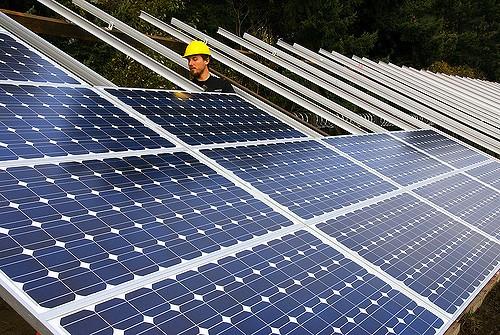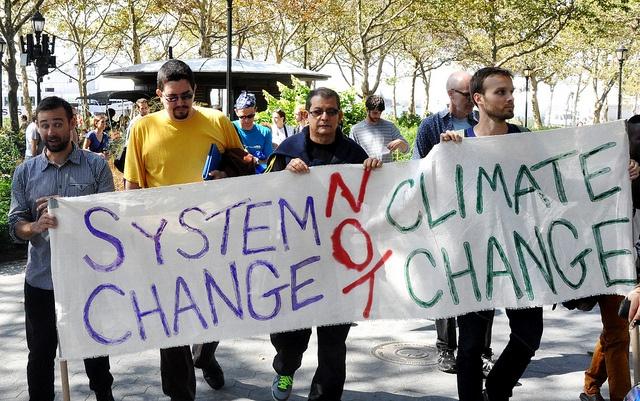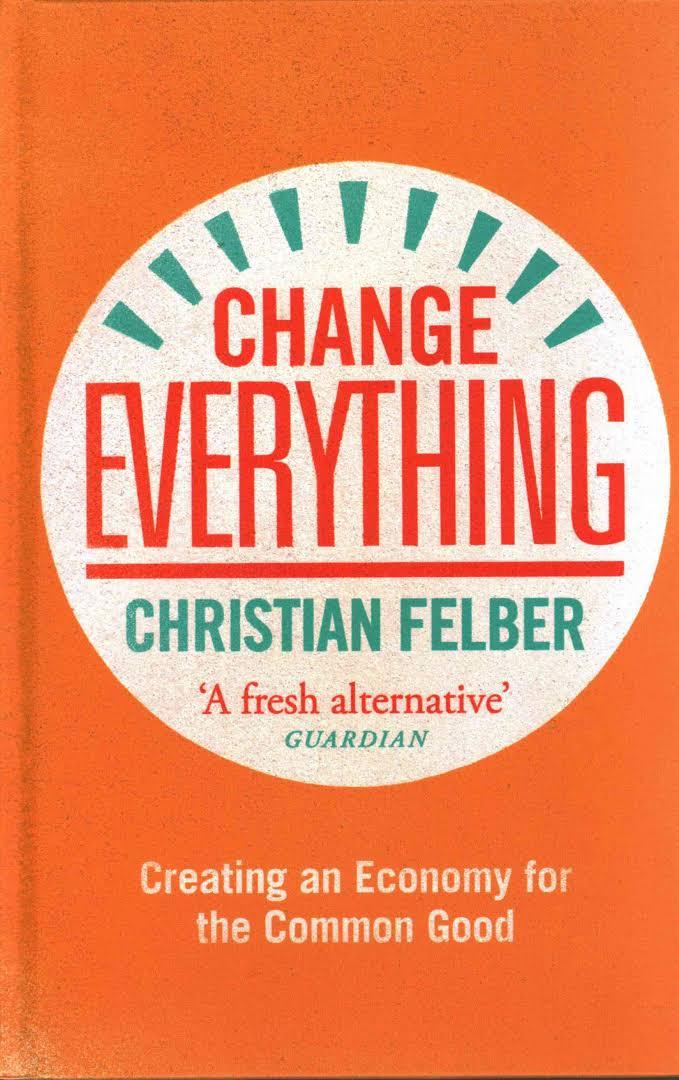Solar and Wind Energy Costs Could Drop By 59 Percent By 2025


The average cost of electricity from wind and solar energy could drop by 26 to 59 percent, according to a new report released by the International Renewable Energy Agency (IRENA). The report, entitled The Power to Change: Solar and Wind Cost Reduction Potential to 2025, finds policy framework and the regulatory environment to be key unknown factors in the future cost of electricity from wind and solar energy.
The report explores the global weighted average levelized cost of electricity (LCOE) of different forms of renewable energy today and in the near future. The LCOE of solar photovoltaic (PV) for example fell by 58 percent from 2010 to 2015, making it more competitive at the utility scale. The estimated LCOE in 2025 is expected to be a mere 6 cents per kilowatt-hour for solar PV and 5 cents for onshore wind energy.
Although concentrating solar power (CSP) and offshore wind energy are "in their deployment infancy," falling costs have already made them attractive in some markets with an LCOE of 15 cents and 18 cents per kWh respectively, IRENA found.
The report finds the global weighted average LCEO in 2025 could fall by up to:
- 59 percent for solar PV
- 43 percent for CSP
- 26 percent for onshore wind
- 35 percent for offshore wind
Solar and wind energy are reaching the critical levels necessary to bring down prices through mass production. Lower prices then increase the demand for the product, furthering greater manufacturing. Renewable energy accounted for 148 gigawatts of new power generation capacity in 2015.
Further decreases in costs will help to further demand, encouraging even lower costs moving forward. Installed onshore wind energy capacity has historically doubled each time there was a 7 percent reduction in the installed costs. Many key factors vary widely by location, including the regulatory environment, installation costs, equipment costs, taxes, transportation costs and renewable energy resources.
Economies of scale, supply chain improvements and technology advances will all help lower the cost of generating renewable energy in the future, IRENA predicts. Competition among renewable energy companies helps to cut costs while encouraging innovation. Solar PV panel costs, for example, are expected to decline by 42 percent by 2025, largely due to manufacturing efficiencies and technology improvements. Solar PV efficiency is on the rise and now requires less square footage to generate the same amount of power.
One important variable in the future cost of renewable energy is policy framework and regulatory environment, as this has a significant impact of the cost, IRENA determined.
The report's authors write: "While industry has often already adjusted its cost reduction strategy to focus on" equipment costs, "much more detailed cost data is required ... in order to identify the potential benefits of different policy options."
"Without these data," they continue, "analysis that can support policy makers in ensuring that policy and regulatory frameworks are streamlined and optimized will be difficult to undertake. This is particularly important, because future cost reductions in balance of system costs, O&M and cost of capital will depend on a more diverse range of stakeholders, not just equipment manufacturers. Careful analysis will be needed to remove a myriad of small barriers, while policy settings must be tailored to ensure all stakeholders are incentivized and able to bring down costs."
Image Credit: Oregon Department of Transportation, Flickrt
Sierra Club’s Leader Trolling Trump, Top Republicans


With the Republican convention in Cleveland less than two weeks away, the GOP is still in a frenzy as at least half of the party wants someone other than Donald Trump as its nominee. The buyer’s remorse and angst over the man who trumped 16 other candidates has had a chilling effect on the convention. And organizers struggled to fill time slots with speakers for the upcoming four-day coronation. Not only are GOP leaders and party elders turning down any opportunity to speak, but many are skipping the event entirely, along with a growing list of corporations that declined to sponsor the convention.
Enter the Sierra Club’s executive director, Michael Brune. Brune and the 124-year-old environmental group already promised to be far more active during this presidential election than in previous campaigns, largely to take down Trump. On the Democratic side, the Sierra Club aligned with organized labor to ensure that party’s convention in Philadelphia includes an aggressive program to repair the nation’s infrastructure. In the meantime, however, Brune is using social media to rip top Republicans over the challenges facing Trump’s candidacy.
For example, Brune called out GOP’s chair Reince Priebus on Twitter over the party’s difficulties in lining up top speakers for the convention. At the same time, he confronted Priebus with polling data that shows a majority of Republicans want to see action taken on issues including climate change and clean energy deployment.
“It’s been all over the news; few VIPs want to be in the same city as your party’s nominee,” Brune wrote in an open letter. “[And] I’d be telling much of the crowd exactly what they want to hear.” Brune continued with data from organizations including the Yale Program on Climate Change Communication, which shows that many Republicans have more complicated views on global warming than the party leadership would have the American public to believe.
And while Trump is naturally the largest target of Brune’s barbs, the Sierra Club head has also taken on other Republicans. Last month, Brune called out former presidential candidate Marco Rubio of Florida for the senator’s hostility to legislation related to climate change, tweeting that the Sunshine State “doesn’t need a senator who buries his head in the sand” while sea levels rise.
Earlier this year, Brune also sent an open letter to half of Koch Industries. Writing to Charles G. Koch, Brune lauded Koch for his reported statement that he believed “the climate is changing” and that “humans have a part in that.” Citing statistics touting the dropping costs of renewables, Brune urged Koch to stop his financial support of groups such as Americans for Prosperity and the American Legislative Exchange Council (ALEC), which critics say have long propped up the conventional energy industry while sabotaging any policies designed to boost the expansion of clean energy.
Whether it is over the dismay of a Trump presidency or growing awareness of the risks of climate change, one thing is clear about this election: Environmental groups, which for decades have largely been on the fringes and sidelines during presidential campaigns, are taking center stage during this campaign. More of the American public, business leaders and even more conservative Republicans are realizing that climate change is not only about preserving American’s quality of life, but is also a compelling business opportunity, as shown by the tactics of those including Michael Brune.
Image credit: Flickr/Michael Fleshman
As Ramadan Ends, a Reminder of What Islam Is Really About


For the expat experiencing Ramadan for the first time in a Muslim country, this month can be a bewildering experience at first. This is especially true in countries such as Saudi Arabia and the United Arab Emirates, where life slows down and business activity closes to a crawl during Ramadan. The ubiquitous restaurants and cafes, where much of daily life and a fair amount of business activity takes place, are closed while the vast majority of the population fasts, from early in the morning until early evening. Then, usually in the early evening depending on the location, the iftar prayer signifies the breaking of the fast. Those who are not Muslim will find their routines have changed.
For the uninitiated, Ramadan is at first jarring, particularly in the workplace. To start, there is no water or food allowed at the desk. If you need your caffeine fix, go to the kitchen or another room that has been sectioned off by a curtain in order to finish off that coffee.
If you happen to work in an economic zone along the Gulf, the rules may be a little more relaxed. But you will find that any eatery open during the day will have curtains covering its windows. On the plus side, office hours will most likely be reduced — where I worked they were from 10 to 4. But if you have an important project or deal that you are trying to sign off, this month can be a frustrating time. Many expats and locals take this time to leave for a trip abroad, and quite frankly, those who are fasting just cannot focus when they are abstaining from food and drink all day.
But annoyances and curiosities aside, Ramadan is an important time for reflection across the Muslim world. While the global media prefers to focus on a few zealots whose actions do not reflect Islam at all, the estimated 1.6 billion Muslims scattered across the globe go about their daily routines. And it is during Ramadan when life for many Muslims takes on the most meaning.
For many Muslims, spread across the world from southeastern Europe to Indonesia, daily routines often center around work. In much of the Muslim world, there is really no concept of a “weekend,” a perk long enjoyed within the Western world. The only day off in many countries where Islam is the predominant religion is Friday, the one day of the week when most Muslims go to the local mosque to pray. On Saturday, the workweek starts all over again — some of the luckier ones may have a half-day on Thursday, but long work weeks are usually the norm. While many of us may be somewhat familiar with the five pillars of Islam, there is arguably a sixth one — hard work.
To outsiders, the long work days typical in much of the Muslim world suddenly end with the start of Ramadan, where now those who are devout Muslims must put themselves in another difficult position: to fast all day. Many Muslims, however, do not see it that way — this month is a time for them to reflect and count their blessings.
And speaking of those aforementioned five pillars, including zakat, the obligatory giving of alms to the needy, Ramadan serves as a reminder of what Islam means to both the individual and society. Whether it is by online donations or the ATM-style machines commonly found in the malls throughout the Gulf region, zakat is amongst the most important ways to give back to society and find that self-purification. The evidence suggests that the practice of corporate social responsibility, still a nascent movement in much of the Middle East and Asia, is in part being adopted due to this important pillar within Islam.
In any event, if expats are jolted by working during Ramadan in a Muslim country, just imagine what it feels like for a Muslim during Ramadan while working in a Western nation.
Lima Al Azzeh, an editorial writer for Slack Technologies, assembled a collection of thoughts from Muslims who adhere to Ramadan’s traditions in the U.S. and Canada. The trials, tribulations, challenges and patience experienced are well worth a read as this year’s Ramadan ends and transitions into Eid al-Fatr, a celebration that is one of the holiest of the year and ends with the resumption of the intense weekly routines for Muslims worldwide.
Image credit: Leon Kaye
Interview: The Impact of Brexit on a Sustainable Future


“Brexit could potentially represent a great risk or a great opportunity to both the EU and to Britain.” So says Christian Felber, founder of the Austrian-based Economy for The Common Good (ECG) movement and the author of "Change Everything: Creating an Economy for the Common Good."
The opportunity for Britain, Felber said, is to move sharply in the direction of sustainability and to address the fundamental misconception at the heart of its economy, one that has led to gross inequality. The risk is that, given the level of fear the exit generated, the country will attempt to become more competitive by resorting to short-term thinking -- slashing environmental regulations and backing away from commitments in order to reduce costs and grab market share with little regard for a future that hangs perilously in the balance.
“The EU is partly to blame by making themselves less attractive to Britain and potentially to other countries.”
The problem in both Britain and the EU, Felber told TriplePundit, is one of “mixing up goals and means.” The stated goal of any economy, going back as far as Aristotle, is to improve the welfare of all -- whether you call it the public interest or the common good.
But today’s economies focus on the means and look at the amount of money being generated instead of the goal. “If what we really want is jobs, health and happiness, which proponents of the GDP claim is what they are looking for, then why not just measure these things directly?”
Brexit occurred because governments in lots of places, and not just in Britain, are not responding to the interests of the people. A poll conducted in Germany found that less than 20 percent supported the use of the GDP (gross domestic product), while 67 percent favored using an alternative metric to guide their economy.
But what’s really at the heart of this is not the metric being used, but rather its consequence: severe inequality and a steady retreat from democracy. In a sweeping opinion poll, between 70 and 80 percent of respondents across the globe felt that inequality is excessive.
That might explain why Felber’s organization is gaining broad support. Since its inception in 2011, it has spread to 40 countries. Over 3,000 volunteers are engaging over 400 companies as well as governments at all levels. What distinguishes them from “friends” such as B Corp and BSR, Felber said, is “the fact that we have a model.” The group is looking to unify some 10 to 20 corporate governance instruments that are being used today into one unified legal instrument that would represent a “common good balance sheet.”
While economies claim to be value-free, our system today -- in which selfish behaviors are rewarded with success and some people figure out how to maximize their means at the expense of others -- perpetuates “values that are adverse to the common good, are opposite to relational and humanistic [values], become contagious into the political sphere,” and encourage “corruption, lying, short-termism and violence,” Felber said.
Felber said U.S. presidential hopeful Donald Trump is a symptom of these phenomena, along with Frank Stronach in Austria and Silvio Berlusconi in Italy. These billionaires have achieved their success by breaking rules and thinking only of themselves. Are these the kind of role models we want our children to grow up to emulate?
While our societies place many restrictions and limitations on individual behavior, there are no restrictions made on the amount of property and wealth a given individual can own. Thus with the leverage of technology, a billionaire class arose. Should there be a limit?
In our world today, there is unlimited inequality. Felber and his organization say there should be limits. People in various countries say they would cap inequality to the point where the highest earners should be paid no more than 10 to 20 times what the lowest earners make, Felber said, citing another survey. Yet in today’s world, that number is 1,000 in Austria, 6,000 in Germany and 360,000 in the U.S., all while deepening poverty corrodes many aspects of society. Felber’s group, citing “sovereign democracy,” wants to convince governments to put a cap directly into their Constitutions.
Now that we’re finally instituting a livable minimum wage, is it time to start talking about a maximum wage?
Felber’s book has been translated into 10 languages. I hope to post a review of it in the near future.
Brexit means a world of uncertainty. But in CRS, we can handle it.


by Claudine Blamey, ICRS Chair, Head of Sustainability and Stewardship, The Crown Estate —Watching the UK’s EU referendum results come in provided more tension, anxiety and delight (at least for 52% of the population) than most acclaimed TV drama boxsets. Since then, the Prime Minister has resigned, his heir apparent has dramatically withdrawn from the race and the opposition has fallen into disarray with a vote of no confidence in their leader. And that’s just the political sphere.
If there is one word that best sums up the consciousness of the nation right now it’s ‘uncertain’. Britain’s decision to end its relationship with the European Union after more than four decades clouds the vision of what the future looks like, and how bright it might be.
As a profession, those of us working in corporate responsibility and sustainability (CRS) are not immune to that uncertainty. There are suggestions that the historic Paris Agreement struck at COP21 last Christmas – the foundations of many CRS programmes – might have to be re-written. Christiana Figueres, the executive secretary of the UN Framework Convention on Climate Change, has suggested Brexit forces the global pact to be “recalibrated”.
However, there are already signs of hope. Fears that the UK’s commitment to carbon reduction would be an early casualty of EU referendum were allayed last week as the Government announced ambitious new targets for 2030.
There will, no doubt, be some calls to de-prioritise the green agenda while business gathers its composure once more and heads into firefighting mode. The strength of a company’s commitment to CRS will surely be tested like never before. Some might argue that it’s easy to do the right thing when businesses are thriving, but the real test of values is surely doing the right thing when things aren’t so clement.
In the coming weeks and months, uncertainty and complexity will be the order of the day, as companies continue to take stock, markets settle down and we all figure out what will be the short- and long-term implications of the vote.
Brexit might be sending shockwaves through industries everywhere right now. But economic and political anxieties should only reinforce a need for companies tominimise future risk,cutcostsand find innovative new ways of doing business.
Thankfully, ‘the unknown’ is not a new bedfellow for CRS professionals and while the fog will take some time to clear, we will continue to help keep business on the right track in ensuring their social and environmental goals are met. We will continue to help build stronger, more resilient businesses. And we will continue to influence and persuade business leaders that robust, sustainable organisations are more relevant than ever.
UK food charities struggle to feed people in need


Neighbourly, the social network for social good, has published the results of a survey of charities and volunteer organisations across the UK which regularly distribute surplus food to those in need.
Conducted in June 2016, the survey gathers the views of 218 charities and volunteer organisations involved in distributing surplus food to those in need. Collectively, these organizations help to feed over 30,000 people every week, equivalent to 1.56 million meals per year.
The results reveal the striking challenges that confront these charities and provide an insight into the problems of tackling food poverty in the UK today.
The primary uses of food surplus were for emergency food provision (54.6%) or regular hot meal provision (33.5%), illustrating the dependency of large numbers of people on the capabilities and infrastructure supporting food charities, and on donations and support from the commercial sector. Organisations cited peaks in demand arise from benefit delay (71.7%), unexpected financial crisis (70.7%) and cold weather (49.0%). School and Christmas/New Year holidays were also major factors.
Despite being relied upon by 30,000 people every week, the survey revealed many of these organisations lack essential capabilities needed to deliver meals consistently and in times of peak need: 47.8% of organisations need more storage space; 40.7% need transport to collect donations; 36.8% lack refrigeration capabilities; 33.0% need better funding; while 28.7% need a more regular supply of contributions. Notably, lack of volunteers and retention of staff were markedly less of an issue.
In line with increasing awareness of the need to provide healthy balanced diets, the willingness to accept fresh food donations was high at 94.9%. However, probably because of the capacity issues highlighted above, while bread (98.1%) and vegetables (96.2%) were almost universally accepted, the numbers accepting dairy (68.1%), food ‘on the go’ such as sandwiches (63.3%) and meat (59.5%) were much reduced. This may point to the lack of capabilities identified earlier (refrigeration, transport), or simply the greater concerns around the safe handling of these fresh foods. The Neighbourly Food service allows charities to request not only food donations but also related help, such as volunteer drivers to deliver food.
The survey is published to coincide with the start of a review of the ‘Guidance on the application of date labels to food’ which commences today at a cross industry workshop hosted by the Food Standards Agency and Neighbourly with representatives from the Food Foundation, WRAP, food charities and major UK food retailers.
The review, which started this week, will explore whether any improvements in food safety labelling and guidance, or better education around it, might increase the volume of surplus fresh food donated and used by the voluntary sector.
Steve Haines, leader of the Neighbourly Food programme, comments: “This survey gives an accurate snapshot of the heroic efforts of groups across the UK in getting surplus food to those who need it most. Food surplus redistribution is a win-win for society. But we need to address the huge gaps in both capability and capacity. We need to help these charities and community projects get whatever is needed – whether that means funds, volunteer drivers to deliver food, consistent food donation supply, or the right tools and infrastructure – in order to better serve those in need.”
Neighbourly connects charities that need help to businesses that want to make a difference. Since launching in December 2015, Neighbourly Food, the Neighbourly platform’s food redistribution service, has worked with charities and retailers across the UK to help share 231 tonnes of surplus food to help people across the country. The Neighbourly Food service is free to charities and causes.
Organisations using Neighbourly include Marks & Spencer, Starbucks and HEINEKEN, as well as many small and medium-sized businesses active in their local communities. Since launching in July 2014, Neighbourly businesses have pledged some £3,875,865, 11,230 volunteer days and 231 tonnes of food surplus. Visit www.neighbourly.com or follow @nbrly.
To find out more about how Neighbourly is working to distribute surplus food, visit https://www.neighbourly.com/aboutfood. Also, visit Food Standards Agency to find out how you can help tackle food waste.
Op/Ed: The Powerful Role of Aviation in Sustainable Urbanization


By John Mandyck Chief Sustainability Officer for UTC
Urbanization is a 21st-century mega-trend impacting the future of aviation.
In 2007, for the first time in human history, more people around the world lived in cities and towns than in rural areas. The United Nations forecasts the addition of 2.5 billion more city dwellers by 2050, meaning two out of every three human beings will live in an urban area.
U.N. Secretary-General Ban Ki-moon has captured the impact of this growth, saying “Urbanization is a driving force, as well as a source of development. It has the power to change and improve lives.”
By creating vibrant consumer markets, clustering production and distribution, and attracting capital and talent, cities generate wealth. One study suggests that by simply doubling the population of an urban area, each inhabitant becomes, on average, 15 percent wealthier and 15 percent more productive. Further, when cities are planned thoughtfully and operated efficiently, they represent the single most sustainable form of community in which human beings live.
Consequently, as cities expand around the world throughout the 21st century, they will generate a new, dynamic middle class that is larger, healthier and wealthier than at any time in history. By 2030, 5 billion people could be members of this global middle class. These individuals will enjoy higher levels of economic activity and greater access to goods and services.
One service they are expected to demand — in extraordinary numbers — is commercial aviation.
In 2015, 3.5 billion passengers flew commercial air; by 2034, that number is expected to skyrocket to over 7 billion, at which time the nations of Asia-Pacific will lead the world in passenger miles. This booming middle class will travel for pleasure, while a growing workforce will require the ability to transact business face-to-face in locations around the world. Despite today’s instantaneous communication technologies, healthy urban centers will need a mobile population to collaborate, grow, and prosper.
As one of humankind’s truly global industries, commercial aviation can have a powerful impact on the growth of sustainable urban environments around the world. To meet the business and personal needs of the new middle class, the global commercial fleet is expected to nearly double — from about 26,000 aircraft today to approximately 46,000 by 2030 — when it will support 103 million jobs and generate $5.8 billion annually in economic activity.
United Technologies, a global leader in building systems and aerospace, has been a principal player at the intersection of sustainable urbanization and commercial aviation for more than a generation. Our Otis and UTC Climate, Controls and Security divisions are focused on urban mobility and the creation of safe, smarter, and sustainable buildings. Our Pratt & Whitney division supplies aircraft engines for commercial, military, business jet, and general aviation customers.
The company’s recently introduced PurePower engine with Geared Turbofan technology, $11 billion and more than 20 years in the making, provides customers with 16 percent lower fuel use, a 50 percent overall reduction in particulate emissions, and a 75 percent reduction in overall noise footprint. In a world where more people take to the skies and the infrastructure of aviation will expand rapidly around cities, these innovations will have an immediate and meaningful impact on both sustainable aviation and urbanization.
We invite you to read our latest research paper, “The Modern Silk Road: Aviation in the Age of Sustainable Urbanization.” It expands on these issues and discusses ways in which the entire aviation industry can help make cities greener and travel more environmentally efficient.
image credit: UTC
John Mandyck is Chief Sustainability Officer for UTC.
What Happens to Donated Clothing?


A staggering 85 percent of clothing and textiles ends up in landfills, even though 95 percent can be reused or recycled. Americans throw away 8.1 trash bags of clothing on average each year or 26 billion pounds collectively. This is surprising considering aluminum beverage can recycling rates in the United States are at 65 percent. Americans embrace recycling household waste, yet unwanted clothing is commonly discarded.
To better understand the scope of the issue and possible solutions, TriplePundit spoke with Tony Shumpert, vice president of reuse and recycling for Savers. This global thrift retailer offers quality used clothing, accessories and household goods, and partners with nonprofit organizations to keep 650 million pounds of reusable goods out of landfills each year.
"We go through every single donated item to determine what is of the level of quality for our sales floors," Shumpert told 3p. "In fact, approximately 60 percent is priced for resale in our stores or makes its way to another process of reuse.
"For other items, we have worked really hard to find different opportunities throughout the world. What can't be used in its original form is put to other uses, such as making cotton T-shirts into rags, installed as the material behind the dashboard in a car, used as insulation or re-spun into a new material."
With more clothing and textiles ending up in landfills than ever, Savers wanted to know why. The company commissioned a study to understand why people aren't doing more to reuse and recycle clothing, and released its State of Reuse Report last month. Creating a significant jump in clothing reuse and recycling rates requires overcoming a few major hurdles, Savers found.
Raise awareness of the environmental impact of the fashion industry
Although it isn't obvious at first glance, the fashion industry has a major impact on our planet. It has even been called the second dirtiest industry in the world after big oil. This is in large part due to the impact of growing and dying cotton, with its astounding environmental impact. Although a mere 2.4 percent of cropland is dedicated to cotton production, it accounts for 24 percent of global pesticide use. It is also a very thirsty crop which often needs to be cultivated on irrigated land.
"It can take over 700 gallons of water to create just one T-shirt and over 1,800 to manufacture a pair of jeans," Shumpert explained. "When you think of that, the more we can donate these products and get them into a reuse stream versus throwing them away, the less burden we put on our environment."
Although many people think twice before throwing a recyclable beverage bottle in the trash, this is not always the case for clothing. When most of us think about polluting industries, we often think of coal power plants or oil refineries, not the T-shirts on our backs. Clearly, reusing clothing to decrease the need for such large quantities of virgin material production is a simple solution.
"Although the rate of recycling for paper products is around 65 percent, clothing is only at a 15 percent rate," Shumpert told 3p. "In fact, 95 percent of clothing and textiles can be reused or recycled.
"More than half of the respondents [in our State of Reuse Report] were more likely to reuse after learning about the clothing industry's environmental impact. This information highlights the fact that there needs to be more education. Tips on clothing and textile reuse could be taught in schools."
Raise awareness of the social benefits of donating clothing
"Donating clothing has a major benefit in communities," Shumpert said. "People donate items to one of Saver's nonprofit partners. They then convert clothing and household items into revenue by selling those goods to us. Through clothing donation, people can support many causes that are critical to serving a wide group of individuals in need in the local community. It creates this opportunity to have this sustainable, consistent, unrestricted funding for their missions."
Some of the organizations that Savers partners with include: Big Brothers Big Sisters, Easter Seals, the Epilepsy Foundation and the YWCA. To make it simpler to donate clothing and household items, Savers stores are also donation centers. The nonprofit partner associated with the store then directly benefits from these donated items.
If people are aware of the social benefits of donating, this can also help boost rates. According to the State of Reuse Report, "Once people do make the decision to donate, helping others outweighs convenience, sparing landfills or even tax write-offs. Sixty-four percent of Canadian respondents and 59 percent of U.S. respondents donate goods to benefit nonprofit organizations."
Make it easier to donate clothing
Of people who do not donate clothing, the State of Reuse Report found that 1 in 3 found it easier to throw items away. Since most of us have garbage cans or dumpsters within feet of our homes, it is hard to make things more convenient than landfilling."I've noticed that donors have shifted and need to have more convenience built into the [donation] process in order for them to be motivated to donate," Shumpert told us. "There is a movement to try to drive more convenience into the [donation] process. In our system, there are donation centers located at our stores, and we are working on broadening donation points with clothing drives to unlock the potential. Many of our nonprofit partners also pick up clothing at a donor's doorstep."
Space constraints can both encourage and hinder clothing donations, Savers found. Running out of closet space was the top reason people were prompted to donate clothing. And the more convenient it is to donate clothing, the less space people will need in their homes to store clothing before donating them, as they can make more frequent trips to donation centers.
So, the next time you notice that long-forgotten sweater or pair of pants in the back of your closet, don't just close the door. Turn your trash into a benefit for both the environment and your community.
Image credit: Pixabay
The Free Market for Internet Access Stops at Apartments


Americans love to talk about the free market, especially conservative Republicans, many of whom are in a tizzy as its nominee, Donald Trump, has for better or worse pitched a protectionist agenda that promises to rip up the USA’s international trade deals. But when it comes to free markets, the reality is far more nuanced. And as anyone who lives in an apartment complex or in real estate terminology, multiple dwelling units (MDUS) knows, the free market certainly does not apply when it comes to internet (and cable) access, whether or not we continue in an age of net neutrality.
The growing problem in the U.S. seems rather counterintuitive when considering the fact that urbanization is on the rise as more millennials, and even empty-nesters, are moving back into the cities. Apartment buildings offer a great opportunity to install the fastest broadband and therefore expand access to the internet. After all, one reason why South Korea has long enjoyed its reputation as being the “most wired” country on the planet is because of the country’s literally sky-high population density.
But as Harvard Law professor Susan Crawford points out in a recent article, collusion between property management companies and the largest internet service providers in the U.S. often leaves citizens paying outrageous premiums for substandard internet access. Crawford highlights research suggesting that a neutral fiber and wireless infrastructure adds to a building’s long term value, but kickbacks given to landlords by internet providers leave tenants little choice but to sign, and overpay, for internet access.
These shenanigans are ongoing despite the fact that several years ago, the Federal Communications Commission (FCC) banned exclusive cable and internet deals within all apartments and MDUs. Internet service providers sued for an appeal, but a federal court upheld the FCC’s ban. Nevertheless, landlords and internet providers have simply found other ways to circumvent the law. As Crawford explains, all a landlord has to do is say “yes” to one provider and “no” to others. Even though the appellate court in Washington, D.C. ruled that the FCC has even more powers to regulate cable companies, the agency’s feeble attempts to do so in the past suggests this problem will not improve anytime soon. Many landlords are ignorant of current internet law, and renters are often too anxious to find a place that is at least somewhat affordable.
The results have several far-reaching effects. Fewer citizens have access to the internet as some simply opt out of internet and cable access since they end up being unaffordable; forcing residents to pay for terrible internet speeds slows down innovation and is a drag on business; and newer companies offering better services, faster speeds and lower prices are frozen out by the lack of competition. Expect this situation to get even more exacerbated as analysts suggest that the U.S. rental population will increase significantly over the next decade.
Image credit: Daniel Foster/Flickr
Positive Progress: 3 Trends in Wastewater Treatment


By Ralph Exton
Water has become one of the foremost challenges affecting the world today. In developing countries, millions of people lack access to clean, safe water. Weather extremes, such as drought are creating dangerous situations; meanwhile, a new released report predicts that by year 2060, more than a billion people worldwide will live in cities at risk of major flooding as a result of climate change.
Then there’s the rapid population growth and economic development in regions, such as the Middle East, where water resources are being pushed well beyond natural limits. And as cities’ aging piping and distribution infrastructure continues to crumble, trillions of gallons of water are lost.
Municipalities in particular are taking the brunt of these challenges. Yet, I believe some of the greatest opportunities for solving the problems exist within their wastewater treatment plants. Last month, leaders in the global water sector convened in Munich, Germany, for the 50th anniversary of IFAT – an influential conference for innovation in water, sewage, waste and raw materials management. Three wastewater treatment trends – and solutions – dominated the discussion.
Water reuse: Closing the gap between treatment and reuse
It is critical that we seek to spur increased adoption of water reuse – a strategy that allows the world to take advantage of a water source constantly replenished every day regardless of drought or climate change. Treated municipal wastewater is a virtually untapped resource. In North America, 75 percent of wastewater is treated (16 trillion gallons of water every day), but less than 4 percent of that water is reused. It’s a gap that needs to be closed.
The vast majority of treated municipal effluent is discharged into a local receiving stream. Technology exists to take this wastewater and treat it to a quality suitable for other, non-potable purposes: agricultural needs, groundwater recharge, industrial applications. In fact, wastewater can be treated to a quality suitable for drinking (if we can get past the “ick” factor of the toilet-to-tap water recycling concept).
Historically, policy has focused on effluent quality, pushing for discharge limits to protect the environment. This is important – and necessary. However, policy and regulation need to catch up with the growing acceptance of water reuse and begin to structure guidance around its implementation. It’s starting to happen in several corners of the world. For example, Saudi Araba increased its water tariff to encourage water reuse. The United Arab Emirates is opting for stronger conservation and reuse rather than investing in desalination technologies, which are effective but expensive.
But resource recovery goes beyond water reuse. It also means we can capture other valuable byproducts from wastewater. Energy is one of them.
Energy neutrality: Harnessing the power of water
The water-energy nexus is real. Without water, you can’t create energy; without energy, you can’t treat water. Consider that municipal wastewater contains two to four times more energy within it than it takes to treat it. Innovative technologies are critical to finding new ways to reduce plants’ energy consumption. Energy-efficient treatment options are gaining ground, such as the MABR (Membrane Aerated Biofilm Reactors) and advanced anaerobic digesters. Advanced digestion can be used to create biogas and reciprocating gas engines can turn that biogas into electricity, creating a pathway to becoming energy neutral or even energy positive.
It’s a revolution in water resource recovery – and it’s underway. Some utilities are already energy neutral; many more are in some stage of planning, designing and constructing water resource recovery systems.
The benefits of energy neutrality extend beyond the individual wastewater facilities. Water resource recovery is a vision and a strategy that is encouraging greater adoption of water reuse around the world. And as a result, water resource recovery is helping to propel a circular economy where water is a valued, well-managed resource sustained by advances in science and technology.
Water quality: Tackling the micro pollutants challenge
Municipal wastewater contains a diverse array of biological solids, nutrients and pathogens; all very common and treatable. More recently, however, a new crop of contaminants are challenging the treatment capabilities of conventional wastewater treatment plants: micro pollutants.
Micro pollutants – commonly originating from sources such as pharmaceutical residues, personal care products, various household chemicals, and biocides/pesticides, these pollutants – are a group of more than 10,000 substances with various chemical properties affecting the environment. The impact of the contaminants’ release into the environment, where they may cause adverse effects on aquatic ecosystems (reproduction issues in fish, among other things), depends on how they are treated within wastewater treatment plants. Many facilities, however, aren’t adequately equipped to handle them.
There is a growing focus, mainly in Europe, on removing micro pollutants from wastewater streams. Switzerland and Germany are two such countries leading the way. Certain regions of Germany, for example, have adopted targets for removal and are providing significant funding for research, feasibility studies and plant upgrades. Advanced technologies like GE’s MBR with MACarrier, which combines membrane bioreactor (MBR) technology with powdered activated carbon (PAC), may be a simplistic, stable and cost-effective process scheme for the removal of micro pollutants. This technology is also proving beneficial for the treatment of other contaminants of emerging concern.
Up until just a few years ago, water-related challenges and solutions such as those above interested only specialists and scientists. They’re now a central concern for many more, including public and private operators, elected officials, associations, and even the general population of involved and concerned citizens. As a society, we’re now recognizing that water management affects us all.
Image credit: Pixabay
Ralph Exton is the chief marketing officer for GE Power, Water & Process Technologies. Ralph also serves as the business program manager for the GE Experienced Commercial Leadership Program (ECLP). Follow Ralph on LinkedIN and GE Water on Twitter.